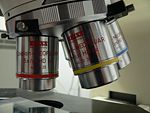- Multiphoton fluorescence microscope
-
A multiphoton fluorescence microscope (MFM) is a specialized optical microscope.
Contents
Description
The MFM uses pulsed long-wavelength light to excite fluorophores within the specimen being observed. The fluorophore absorbs the energy from two long-wavelength photons which must arrive simultaneously in order to excite an electron into a higher energy state, from which it can decay, emitting a fluorescence signal. It differs from traditional fluorescence microscopy in which the excitation wavelength is shorter than the emission wavelength, as the summed energies of two long-wavelength exciting photons will produce an emission wavelength shorter than the excitation wavelength.
Multiphoton fluorescence microscopy has similarities to confocal laser scanning microscopy. Both use focused laser beams scanned in a raster pattern to generate images, and both have an optical sectioning effect. Unlike confocal microscopes, multiphoton microscopes do not contain pinhole apertures, which give confocal microscopes their optical sectioning quality. The optical sectioning produced by multiphoton microscopes is a result of the point spread function formed where the pulsed laser beams coincide. The multiphoton point spread function is typically dumbbell-shaped (longer in the x-y plane), compared to the upright rugby-ball shaped point spread function of confocal microscopes.
The longer wavelength, low energy (typically infra-red) excitation lasers of multiphoton microscopes are well-suited to use in imaging live cells as they cause less damage than short-wavelength lasers, so cells may be observed for longer periods with fewer toxic effects. Many researchers are currently working toward better and higher resolution multiphoton imaging developments.
See also
References
External links
- Molecular Expressions introduction to multiphoton microscopy
Illumination and
contrast methods
Fluorescence methods Fluorescence microscopy · Confocal microscopy · Two-photon excitation microscopy · Multiphoton microscopy · Image deconvolution · Total internal reflection fluorescence microscopy (TIRF)Sub-diffraction
limit techniquesDiffraction limit · Stimulated emission depletion (STED) · Photo-activated localization microscopy (PALM) · Near-field (NSOM/SNOM)Categories:- Microscopes
- Cell imaging
Wikimedia Foundation. 2010.
